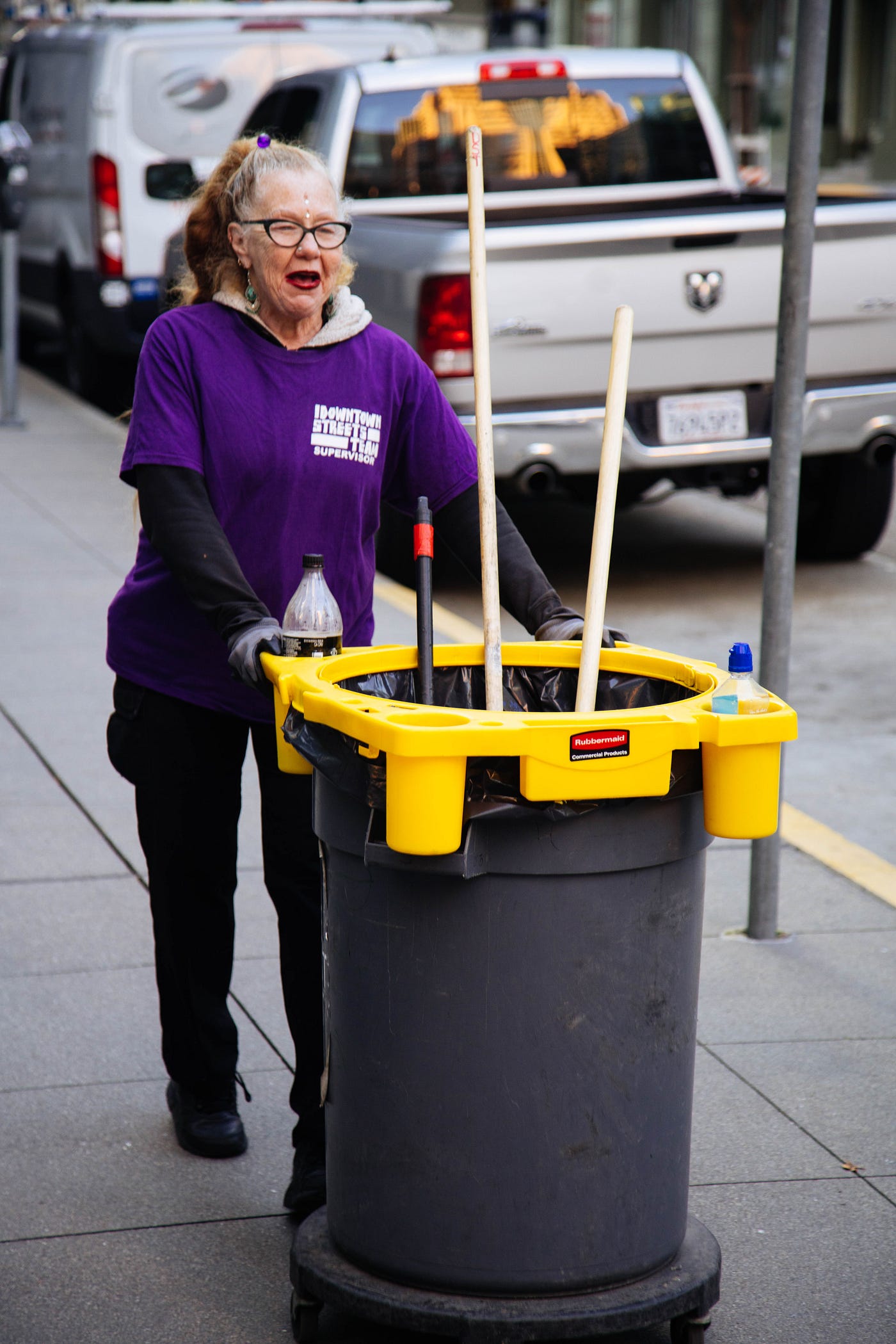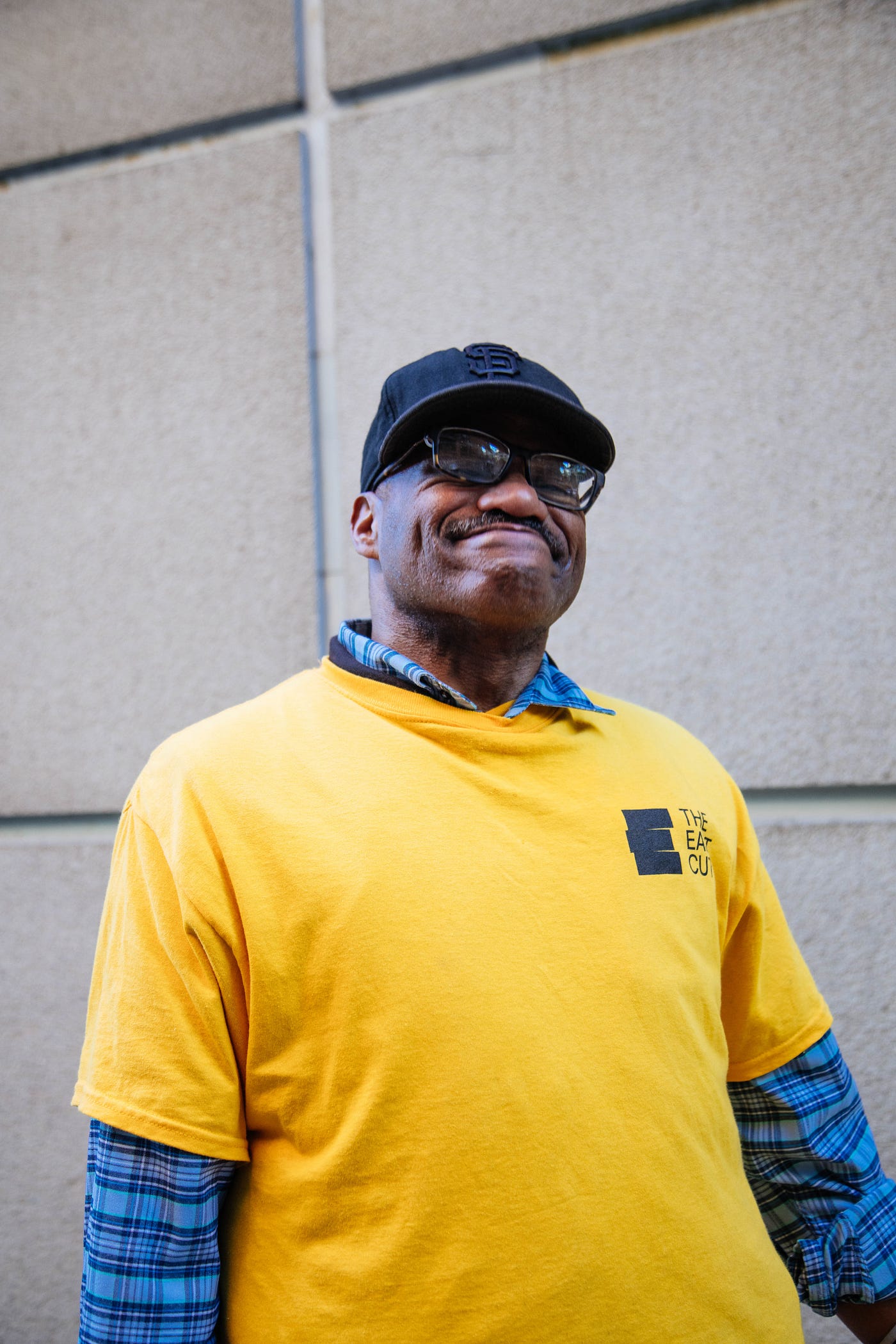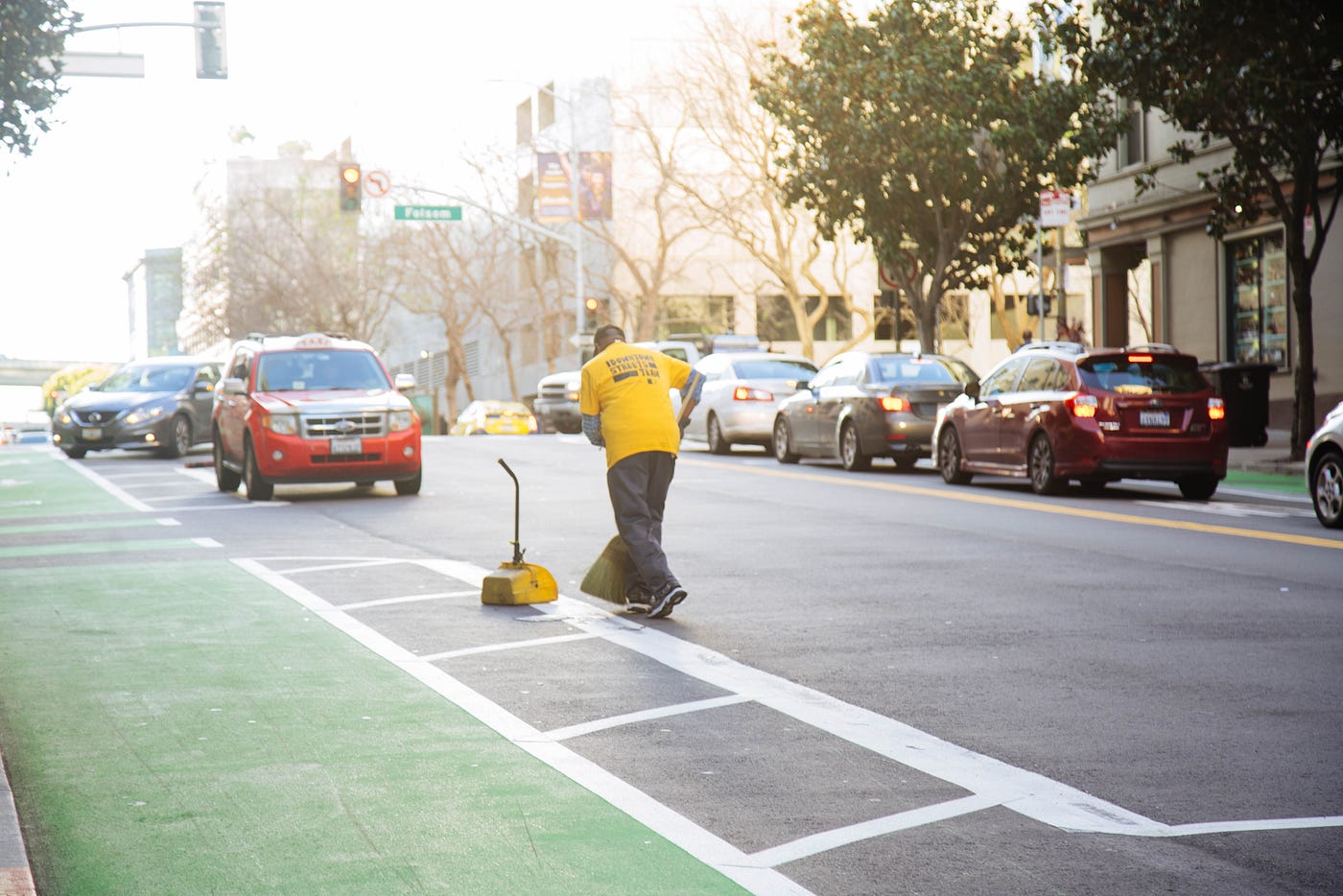
It’s a brisk Tuesday morning in the East Cut, the recently rebranded downtown neighborhood around Salesforce Tower, and Donna* has just discovered a box of needles sprawled out on the street. Expertly, she peers inside the lid of the telltale red box, identifying several used sharps, and drops the bucket into the depths of her rolling garbage can.
Finding used and discarded needles isn’t unusual for Donna, who serves as a team supervisor for the Downtown Streets Team. She’s been around the block (literally and figuratively) a few times, cleaning the streets of the city Monday through Friday for four hours a day.
“I’m always on the lookout for needles,” Donna said. “Because addicts will often try to reuse them if they find them.”
You’ve probably seen the Downtown Streets Team around, with their telltale yellow vests, rubber gloves and wheeled trash cans in the graffitied alleys of the Mission and the crowded streets of the Tenderloin. The idea behind the organization: to give homeless and low-income people a job and resources to get their lives back on track.

I recently spent the morning with Donna and her team. By 7:00 a.m., we were out roaming the East Cut and unearthing cigarette butts, plastic bottles, and, yes, needles too. While this neighborhood has by no means the same level of drug use or homelessness as the Tenderloin, we passed by tents where people remained asleep under the freeway, people whom Donna knows well. She understands how it is — she was homeless once too.
The Downtown Streets Team has removed over 791,000 gallons of debris and 36,000 used needles from the city’s streets, parks and public spaces since it was founded.
Founded by Silicon Valley figurehead Eileen Richardson (former CEO of Napster) in 2005, the Downtown Streets Team aims to get people off the streets by offering employment that betters the community around them. In exchange for their time spent cleaning the streets every day for four hours, team members receive a basic-needs stipend ranging from $60 to $240 per week (depending on their leadership status in the organization) for rent, storage, a cell phone or groceries.
In total, the Downtown Streets Team has removed over 791,000 gallons of debris and 36,000 used needles from the city’s streets, parks and public spaces since it was founded. The organization has seen over 880 team members find long-term employment at an average of 8 per month — and 640 team members have been rehoused. The organization’s territories have expanded from the Ferry Building all the way down to the end of the Mission, and it now operates 13 branches across the Bay Area.
With success in a city that has one of the most complex relationships with its homeless, the Downtown Streets Team hopes to grow its model even further outside the Bay Area — and has major plans to expand outside the region soon.

Donna maps out the route we’re going to take before we start. Her team — second in command (and amputee) J. T. T., camera-shy Celeste L. and George G. (like “of the Jungle,” he tells me) — pick up trash and dispose of harmful waste products. J. T. was out last week after getting a cortisone shot in his arm to lessen the phantom-limb pain caused an infection. He shows me pictures from the hospital
Throughout the walk, J. T. peppers in words of encouragement to the rest of the members — “good job, guys” and “way to go” — to help everyone warm up from the morning’s cold temperature. It’s clear how much direct impact the organization has on the streets, but the most impactful growth happens with its people. The peer-to-peer consistency—having a team to answer to and showing up for work each day—serve as the backbone of the Downtown Streets Team’s success.

Through case managers and employment specialists, team members work on résumés, find affordable housing and get support on tougher-to-tackle tasks, such as going to the DMV. With pipelines into community employers, the Downtown Streets Team finds employment at organizations such as Whole Foods (a supporter of the program) and janitorial positions through Block by Block.
“The beautiful thing is the community and accountability we build,” said Brandon Davis, the San Francisco branch director. “We take a lot of time to assist in building confidence, communication skills and problem solving.”
“We need a visible solution to homelessness, challenging the myth that there aren’t unhoused folks interested and willing to get on their feet and earn their way with the on-ramp of tools we provide.”
While rehousing is an important goal for the program, the organization’s focus is largely the other steps it takes to get people off the streets. Downtown Streets has seen success with Employment-Based Rental Assistance — a two-year subsidy granted once an individual gains employment, whereby the person allocates 30 percent of their income for rent—but on the whole, the organization partners with housing-specific initiatives, such as San Francisco’s own priority housing placement program.
In the current housing market, it’s not realistic to assume that every single person who comes through the program will be rehoused. Instead, Davis believes that homeless people seeing a group of their peers rebuilding their lives and contributing to a goal can be a motivating factor for them to get involved and make a step in the right direction.
“Continuing to build housing is essential, but in the meantime, we probably won’t see street behavior change until we address the perceptions around homelessness that exist here,” Davis said. “We need a visible solution to homelessness, challenging the myth that there aren’t unhoused folks interested and willing to get on their feet and earn their way with the on-ramp of tools we provide.”
The organization’s visibility is typically how members find the program in the first place, Donna said. She’s always doing outreach during her walks as a type of guerrilla marketing for the organization. As Davis explained, seeing a homeless friend whom you might have slept on the street with holding their head high, with a uniform on, may make you want to get involved too.
Yet with a $16 minimum wage and the highest rent prices in the country, it can be hard to believe that the crisis will ever be solvable in the Bay Area. People often ask Davis why the homeless community doesn’t just leave the city — but, he said, this is their home.
“Everything they know is in the Bay Area,” he explained. “If they’re volunteering on our team and are dedicated to being part of it, we can make a change. Homelessness is an experience, not an identity.”
According to Roscoe “Hollywood” Brown, a Mission street-team member and practicing magician, the magic lies in the work. Brown, whom I’d peg to be around 75, is not currently homeless but had been previously for almost half a year. He once cleaned up 20 bags of trash in a single mission alley. He lives in subsidized housing for the elderly and says he doesn’t really need the support the organization lends him — rather, he’s in it for the work.
“It provides the opportunity to maintain healthy work, get into a habit and come in where you are,” Brown told me. “I think of the sanitation workers in Memphis [to whom MLK spoke the night before his assassination] — ‘If you’re going to be a sanitation worker, be the best that you can be.’”
The somewhat limited research on this topic shows that routine is an important factor in combatting homelessness — whether that’s sleeping in the same place for a week, frequenting the same shelters for resources or having an obligation to make once a day. A study from the journal Occupational Therapy in Mental Health explains that homelessness can impact how people form social connections and use their time, especially young people. The findings were used to develop community programs to cement routines and create opportunities for productive activities.

One day, Davis hopes, the Downtown Streets Team’s ideas will reach other cities. Already in San Jose, Oakland, Palo Alto and other cities, the organization is in the process of building an affiliate network so governments can adopt the model in other cities. As Davis said, Los Angeles, New York City, Chicago and Honolulu could benefit from a program his team has already seen work. Other cities, such as Albuquerque or Fort Worth, have launched similar initiatives independently. The Downtown Streets Team has spent the last two years working with consultants on an affiliate network model and is in the process of raising funds to build the team that supports it.
“When I got to SF, I realized that the people here are so disconnected — the tech industry, the government, the small businesses and the unhoused,” Davis said.
For Davis, the work still starts on the ground—every day—through forging connections. And for the average San Franciscan who sees these team members on the streets, the best way to start the seeds of change, he said, is to just say hi.
If we all can acknowledge our mutual humanity, he believes, we might find more empathy and spark an important interaction that could lead to getting someone off the streets. Or maybe nothing will happen, and it will just make their day — that’s OK too.
“When I got to SF, I realized that the people here are so disconnected — the tech industry, the government, the small businesses and the unhoused,” Davis said. “Homelessness can be so isolating; that’s why people are shooting up in BART stations. They’re completely ignored and sometimes don’t buy into social norms because of it. We have to begin with an understanding of each other, a sense of humanity.”
*Last names have been removed to retain the anonymity of the members of the Downtown Streets Team.







